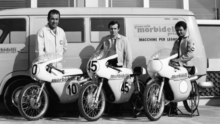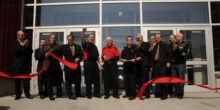Oct. 5, 2009 – Capitalizing on Internet sales
By Karin Gelschus
Associate Editor
INDIANAPOLIS — “If you’re online sales aren’t up (year over year) or if you’re not selling somewhere north of $240,000 (of online PG&A), you could be,” said Roy Olivier, president and CEO of ARI. “Our average dealer sells about a quarter of a million dollars online in PG&A. Our best practices dealers sell over $10 million in a year.”
Olivier was one of four members of the “E-commerce” panel at the PowerSports Business Conference and Expo. The panelists discussed how to increase a dealership’s online sales and how to make sure consumers have a positive online experience.

In addition to Olivier, the panel consisted of Mike Jackson of World of Powersports; Dave Hogge, executive vice president of 50 Below; and Craig Cervenka, OEM relations manager at PowerSports Network (PSN).
In the hour-long discussion, the group also discussed how to promote a dealership’s Web site and involve much of the staff.
Creating a Web presence
If you want a good online experience, go to Best Buy, says Cervenka. Its Web site reflects the customer’s experience in the store. The challenge for dealerships is consumers expect that same level of experience, regardless of whether it’s a $1 billion company or a substantially smaller company.
If a dealership currently doesn’t have a Web site or has an amateur one, Jackson says they need to invest in an online provider like 50 Below, PSN or ARI.
“If you don’t have a Web site with one of these three guys, you need to do so in the next month,” he said, “because you cannot build a Web site in your building using (a computer software) a high school kid knows.”
In order to give customers a positive experience, a dealer should view its Web site as an extension of the dealership. Jackson said, “It should be a virtual dealership.”
What does that mean?
“The key here is the Web site is a dealership in itself. You must duplicate all the activities you do in your dealership on your Web site,” Jackson continued. “You have to have a parts department, sales department, service department, you have to load all your physical inventory. You’ll see customers drive four hours to buy a unit from you because they’ve already seen pictures of it on your Web site.”
Increasing revenue
Once the site is up to par, it requires a certain level of time and effort to make and keep it profitable. A major aspect in making a Web site successful is updating it consistently.
Olivier of ARI says when he worked in retail, they reconfigured the showroom and their marketing every month. He says that same approach should be applied to the Web as well.
“We know what people do during their 8-5 work day, they’re searching the Internet looking at what they’re going to buy that weekend,” Olivier said, laughing. “Customers will visit your Web site regularly, but if they don’t see that site change, they stop going there. We see a lot of dealers throw up a Web site, and they don’t do anything with it. If you change something up in the store as far as what you’re promoting, you should change that on the face of your Web site, which should be on a monthly basis to draw people in and convert them into a sale or a lead.”
The key difference between dealers who do OK with online sales vs. those who do great is the effort they put into the site, says Hogge. “We talk about people who are making $10- $20-, $30 million online,” he said, “those people are extremely dedicated to that part of the business.”
The online part of the dealership’s business needs to be a part of multiple staff members’ jobs. It can be worked into what they’re already doing in the store.
“Get your sales people involved,” Hogge said. “Most sales people aren’t commissioned on online sales. Sales people will actually not tell their customers they have a Web site.”
Jackson suggested a way to get them to write them down in the traffic log.
“The guy who writes their name in the book gets the commission,” he said. “If I’ve been dealing with you through the Internet and write your name in the book, if you come in on my day off and someone else closes the deal, I get the commission, or the two could split the commission. You try to give it back to the guy who started the sales.
“Internet leads are no different and shouldn’t be any different than when a customer walks through your door,” he added. “That first contact needs to be written down in that book for follow-up sales.”
Like the sales people, Jackson says make it a part of the parts employees job as well.
“If your parts people are being commissioned on sales, they don’t want people to buy on your Web site because that’s a lost customer,” he said. “We have promo codes on your Web site for 5 percent off or whatever it is. What we do is set up a promo code for each salesperson, and when the order comes through the Web site and they enter that promo code, we pay that sales person their commission on the sale.”
Online leads
Before the expo, ARI conducted online mystery shopping of the dealers. ARI sent sales leads to each dealer and recorded how quickly they responded and what their responses included. Only 66 percent of the dealers gave some response to the lead. Of that 66 percent, the average response time was 31 hours.
Olivier says ARI’s best business practice dealers are expected to respond in less than an hour. Jackson says the reason response time is critical is because the customer is most likely e-mailing more than one dealership about the product he or she is looking for.
“He’s probably e-mailing five other dealers on the same bike,” he said. “They’re already sitting at a computer somewhere when they send that request, so you need to e-mail and call, both. The key is to start a customer relationship with them. Start by answering the question.”
To improve the response time, Hogge says dealers need to have someone assigned to monitoring the e-mails that come in via the Web site. “The owner or manager has to check up on that to make sure it’s getting done,” he said. “Assign someone and hold them accountable.”
Olivier says one way to do that is through a BlackBerry. “When a customer requests more info for a vehicle, he fills out a form online to request that info,” Jackson said. “It sends a text message to the Internet sales manager’s phone.”
Along with response time, the quality of response is also important to make it easier to turn those leads into sales, says Olivier. The mystery-shopping project revealed that only 18 percent of the sales people who responded to those leads attempted to get those leads on the phone.
“We have a lot of responses that just say, ‘Yes.’” Olivier said. “We have a lot of responses of, ‘We have a red one and a blue one.’ They don’t try to get the user’s phone number. You need a nice three-four sentence response.”
Jackson gave an example. “If they’re question is, ‘Is this bike in stock?’ your answer needs to be something like, ‘Yes, here’s the payment, here’s a number you can call me back at.’ Otherwise you’re going to be going back and forth too much and you might lose them. These guys are buyers on the Internet. They’re ready to make a purchase today.”
E-mails aren’t going to sell bikes, notes Olivier. “The key is getting that person in the store and on the scene,” he said. “Having a process to get that customer in the store is critical to converting them into a sale.”








